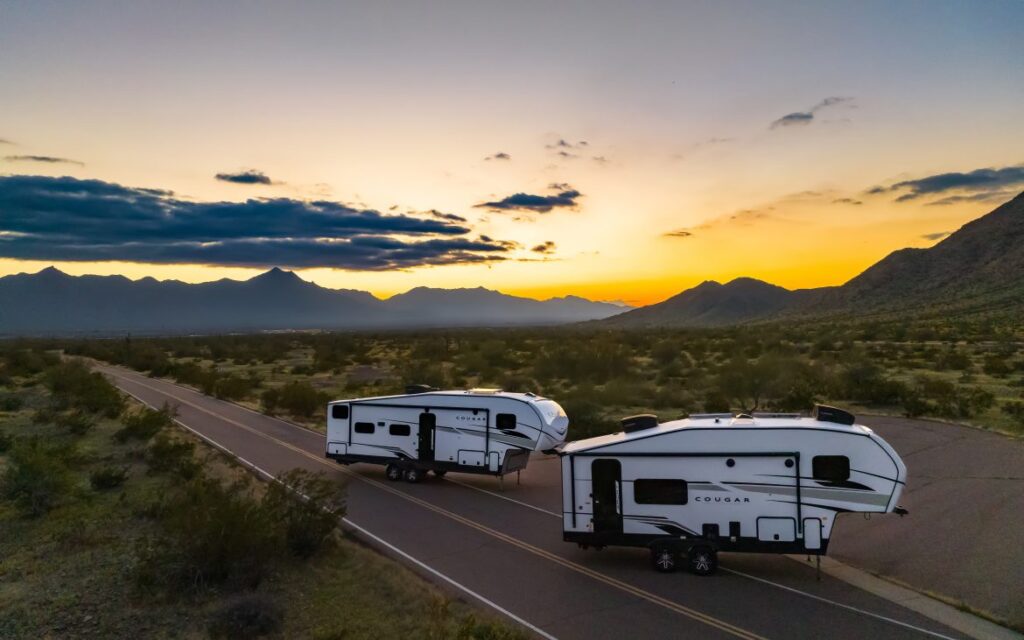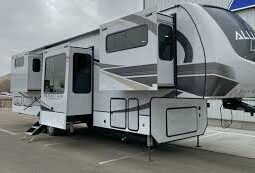Hit the Road with Confidence: Understanding and Improving Your RV’s Tow Capacity
4 min read
Your RV is like a trusted steed, ready to roll across the plains. But even the most majestic steeds have their limits. If you push the limits while towing, you could end up in a frightening situation.
It’s all about balance, a harmony between RV and your towed vehicle (TOAD). Similar principles apply if you tow a travel trailer with your truck or SUV.
Understanding and improving towing capacity isn’t just about the mechanics. It involves understanding weight ratios, and also getting a feel for the road’s rhythm—knowing when to speed up and when to slow down.
The Secret Language of RV Tow Capacity
Imagine tow capacity as the force that determines the ultimate dance between your RV and the vehicle it carries. It’s the maximum weight your RV can pull, turn, and maneuver without breaking a sweat.
There are several acronyms and terms that aren’t part of our everyday language. Let’s unravel the alphabet soup by looking at the big three:
GVWR (Gross Vehicle Weight Rating)
Maximum weight your vehicle (or trailer) should carry, including passengers, fuel, and cargo. Exceeding this limit can turn your RV into a grumbling giant, struggling under its own weight.
GCVWR (Gross Combined Vehicle Weight Rating)
Maximum weight of an RV with a tow vehicle, or a vehicle with a trailer attached. Go overboard, and it’s like inviting too many guests to dinner– the table might collapse.
Tongue Weight
The downward force exerted on the hitch ball of a towing vehicle by the trailer or TOAD. Proper tongue weight is crucial for safe and stable towing.
When you’re cruising down the highway, tow capacity is your dance partner, guiding every step of the way. It’s the difference between an elegant waltz and a clumsy two-step.
Factors that Impact Tow Capacity
You can meticulously follow the tow capacity specs provided by the manufacturer of your RV, but that doesn’t guarantee a smooth ride. Other factors come into play, including:
Engine Power: Your RV’s engine determines how effortlessly it can conquer hills and accelerate on the highway.
Transmission: A transmission built for towing, with ample gear ratios, helps your RV effortlessly switch between power and efficiency.
Axle Ratio: This determines how efficiently your towing vehicle handles heavy loads.
Cooling Systems: A well-designed cooling system keeps your vehicle’s performance steady, even during challenging terrain and weather conditions.
Keys to Improving Tow Capacity
Towing isn’t a solo performance—your RV and the trailer must dance in unison. Proper weight distribution prevents swaying or fishtailing.
Good aerodynamics reduces wind resistance. This allows your RV to glide down the road effortlessly.
A trailer with a good braking system is another positive influence on tow capacity. Trailer brakes coordinate with the brakes on your rig to help with safe deceleration.
Cracking the Code to Calculate Tow Capacity
Calculating tow capacity is a little like solving a puzzle. Each piece contributes to the bigger picture. Let’s demystify this process.
Get familiar with your RV’s specifications—engine power, transmission, axle ratio, cooling capacity, and GVWR. Look at your trailer’s details, such as weight, tongue weight, braking system, and any modifications.
Locate your RV’s tow rating in the owner’s manual. Next, factor in the trailer weight, including all cargo. This sum should never exceed your RV or towing vehicle’s tow rating.
Don’t forget to include a safety margin to prevent pushing your towing vehicle to its limits. Deduct 10-15% from your RV’s tow rating. The result is your ideal towing capacity.
You can use an online tow capacity calculator like this one. It still relies on your input, but keeps things streamlined.
Fine-Tuning Performance to Improve Tow Capacity
Enhancing your RV’s tow capacity can transform your road trip from good to extraordinary. It all starts with regular maintenance. That means oil changes, fluid checks, and inspections.
Maintain tire pressure. Properly inflated tires provide stability and help with efficiency.
Most campers over pack and end up overweight. Balance is key. It’s vital to disperse weight across the RV and your tow vehicle/trailer.
The Magic Ingredient to Better Tow Capacity
A tow package includes components and modifications that improve the ability to safely and effectively tow trailers or other heavy loads. Common features found in a tow package may include:
A larger radiator and transmission cooler to prevent overheating
Sturdier springs and shocks to handle the extra weight and maintain stability
Advanced brake controller for improved braking performance when towing
Higher axle ratio
Integrated trailer wiring for safe trailer lighting and brake signals
Reinforced frame to support the added stress of towing
Trailer sway control system
Vehicle manufacturers offer tow packages as optional upgrades. You can also buy an RV or towing vehicle with a factory-installed tow package.
Enhancing tow capacity isn’t about overpowering—it’s about fine-tuning. Optimize maintenance routines, upgrade essential components, and explore modifications. Do these things and you’ll make your towing experience safer, which, of course, makes the road trip better.
The post Hit the Road with Confidence: Understanding and Improving Your RV’s Tow Capacity appeared first on Unique RV Camping with Harvest Hosts.



